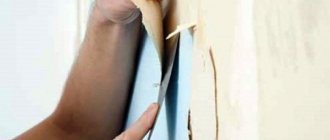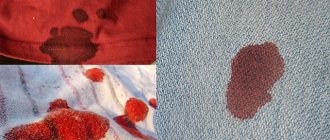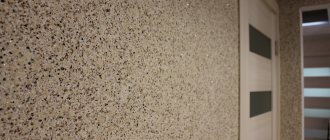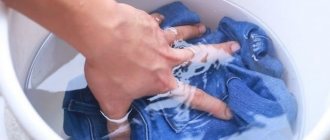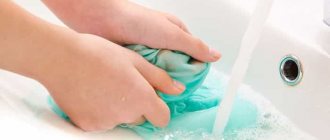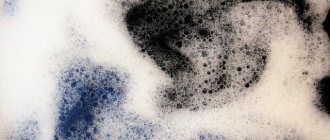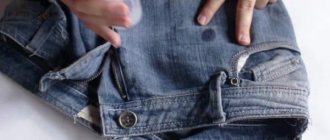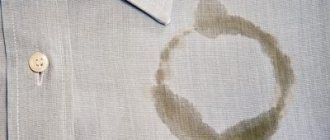Repair is a labor-intensive and tedious task, but the result is worth all the physical and mental effort. It is very unpleasant when the overall impression of the renovation is spoiled by stains on the wallpaper, and if they appear immediately after gluing, then this is doubly sad.
But nothing is impossible, and stains from wallpaper can be removed. You don’t need to re-stick them, but just have various cleaning products on hand.
Pollution appears for various reasons:
- the child touched the walls with dirty hands;
- oil splashed from the frying pan;
- careless use of food;
- the appearance of mold on the walls;
- The walls are not dry enough.
Used:
- low-quality wallpaper glue;
- colored primers for walls.
In contact with
How to deal with dark spots
What to do if dark spots appear after wallpapering? Moreover, they can appear either immediately or after a week. As one of the possible options, this may indicate that mold appeared through the wallpaper, after which they, in fact, became covered with stains. In any case, in such a situation it is advisable to react immediately.
What could have caused
First of all, you need to try to determine as accurately as possible the reasons that could lead to dark spots appearing on the wallpaper after gluing. At the same time, it is necessary to remember that in most cases the very source of the appearance and spread of mold is under the wallpaper. So here are the main reasons:
- High level of humidity in the room, coupled with poor ventilation and lack of airflow.
- No preparation was carried out before gluing.
- Antiseptic compounds were not used when performing preparatory work before gluing.
Whatever the cause of the problem, to solve it you must first get rid of the old wallpaper. No anti-fungal composition, even the most modern, can prevent the stains from reappearing if you do not remove the old wallpaper. So, you'll have to do it. In addition, before removing stains from the wallpaper, you will need to create a good microclimate in any case. The step-by-step algorithm of actions that you will have to carry out after this is as follows:
- Move all pieces of furniture to another room and wipe them down with a rag soaked in hydrogen peroxide.
- The surface of the walls in problem areas should be cleaned with sandpaper, and then the dust should be removed by thoroughly washing these areas.
- Next, take a mildew and mildew killer and apply it to the entire surface of the wall.
- After this, treat the wall again with a dampened rag or sponge, thus getting rid of the remaining particles of dust and dirt.
- Apply a second layer of antifungal agent and after that you can proceed to gluing.
Now you know exactly why dark spots appeared on the wallpaper and what should be done in such a situation.
Attention! To ensure safety for your health, try to wear a mask while performing work. In addition, do not forget to ventilate the room.
Dark spots: causes and solutions to problems
This problem is perhaps the most serious, because if dark spots appear on the wall, this may indirectly indicate that mold may have appeared under the wallpaper. Therefore, if some time after sticking you begin to notice something like this, you will need to take urgent measures to immediately eliminate it.
Causes and solutions
Before you think about what to wash and how to decorate dark, sometimes even black mold stains, you need to know the reasons why such areas appeared on the walls of the room. Moreover, in the vast majority of cases, the fungus appears under the wallpaper, and not on it. In fact, there are three main reasons:
- Incorrectly performed repairs without antiseptic treatment.
- Poor microclimate in the room: high humidity and lack of airflow and ventilation.
- Pasting on a rough wall (for example, on top of plaster), without preliminary preparation and priming.
In any of the above cases, it is necessary to remove the old wallpaper surface. Without this, no antifungal agent will help you. And even if it helps, it will only be for a while, after which dark mold spots under the wallpaper will appear again. So, to solve the problem, it is necessary, first of all, to create a favorable microclimate in the room. Then you need to perform some actions. So, here are the detailed instructions:
- Temporarily remove furniture from the room and treat it with a sponge or cloth soaked in hydrogen peroxide.
- Completely remove old wallpaper from the walls.
- Prepare the surface by sanding it down.
- After this, remove the dust, or even better, thoroughly wash the work surface.
- Apply a mildew and mold preventative to the entire wall.
- Wipe the wall again with a damp cloth to remove dust and remaining materials.
- And only after additional application of primer with antibacterial and antifungal properties is it permissible to begin wallpapering.
Do not forget that when carrying out this work it is necessary to ventilate the room well. In addition, to ensure your own safety, use a special mask; this will protect your lungs and other respiratory organs.
Why non-woven wallpaper is see-through and what to do about it
Non-woven wallpaper is very popular due to its ability to hide minor surface defects and maintain its original appearance for a long time even when directly exposed to ultraviolet radiation. The material is characterized by mechanical strength and wear resistance. It does not attract dust and fully complies with fire and environmental safety requirements. In addition, non-woven wallpaper can be used in finishing rooms with high humidity; they can easily be wiped with a damp cloth or vacuumed when cleaning.
Getting rid of greasy stains
So, we found out what to do with mold. How to remove grease stains from wallpaper, paper, non-woven, vinyl, etc.? As some consolation (compared to the previous case), we can mention that by eliminating grease and the consequences of it getting on the finish, you most likely will not have to re-stick the wallpaper. Although, of course, there are all sorts of cases. This type of pollution also has its own “varieties”, which can be caused by various reasons. Here is a short list of them:
- Contact with plasticine (we are talking about a children's room).
- Contamination with small pieces of food, especially in the kitchen and living room, since some people prefer to have lunch or dinner in this room.
- Inattention to certain sources of fat (oil, etc.).
At the same time, there are several options for how to remove greasy stains from wallpaper. As a rule, the choice of one method or another depends directly on the type of material from which the wallpaper was made.
Paper
It is paper wallpaper, and sometimes textile (fabric) wallpapers, that are among those types of finishes that are most susceptible to the effects of grease and the occurrence of greasy stains. At the same time, this does not mean that cleaning such wallpaper is impossible. Quite the opposite: knowing how to remove fat, you can do it without any significant complications. The so-called thermal method will help you with this. To do this, you need to use a napkin or a sheet of white paper, attach it to the problem area of the wall, and iron it on top with an iron. In some situations, this approach will not work: which means it makes sense to use alternative methods, one of which involves the use of ordinary gasoline. Here's what you'll need to do:
- Take 1 teaspoon of gasoline (about 5 ml) and mix it with 2 teaspoons of starch.
- Carefully apply the resulting mixture to the contaminated areas and wait for 1.5-2.5 hours.
- After this time, the gasoline should evaporate.
- When this happens, take a stiff-bristled brush and scrub the problem area.
Remember! At least one of the above methods should help completely remove the grease stain from the wallpaper.
Other types of wallpaper
In this case we are talking about the so-called “heavy” wallpaper: vinyl and non-woven. Despite the apparent initial complexity of the task, removing stains from such surfaces can be even easier than with their paper counterparts. To do this, it is quite enough to simply wipe the dirty area with a cloth, or you can use a cleaning agent.
How to deal with greasy stains on wallpaper
Grease stains are the most common stain on wallpaper.
They need to be washed off as quickly as possible, because after a week they will be more difficult to remove. Before you start cleaning the wallpaper, you need to determine what type it is:
- detergent;
- liquid;
- non-woven;
- vinyl;
- paper
The method of cleaning it from grease stains will depend on the type of canvas.
Please note: the methods described below are not suitable for removing stains from single-layer paper wallpaper.
Before any method of cleaning walls from stains, apply the cleaning mixture to an inconspicuous area of the wall to prevent unwanted fading and damage to the wallpaper.
So, here are some ways:
1 way
If the stain is fresh, it can be washed using:
- cleaning powder;
- dish gel;
- liquid soap;
- washing powder.
To do this you need:
- Dilute the product in a small amount of water.
- Blot the resulting mixture onto a sponge or soft cloth.
- Rub the stain without pressing too hard with your hand.
- Rinse the cloth or sponge in clean water and remove any remaining detergent;
- If the stain partially remains, repeat the procedure again.
Method 2
Dirt from wallpaper can be removed using laundry soap.
To do this you need:
- Lather up a small rag.
- Wipe the stain.
- Rinse off the foam with clean water.
- Repeat steps if necessary.
You might be interested in learning how to properly glue wallpaper in corners. Read here which glue is best to choose for wallpapering. In this article you will learn how to remove bubbles from wallpaper.
3 way
Oddly enough, tooth powder will help clean the walls from greasy stains.
You need to make a paste out of it using a small amount of water. The consistency should be like thick sour cream. Further:
- Apply the resulting mixture to the stain.
- We are waiting for it to dry completely.
- Gently brush off with a brush or sponge.
This is important: chlorine-containing products cannot be used to remove any dirt from wallpaper!
Removal methods
If contamination occurs during operation, you will have to take measures to clean it. First, determine the type of wallpaper material.
Means for washing away contaminants:
- Detergents are not recommended for cleaning paper wallpaper, although the method is effective. Wipe off stains with a wet sponge, then wipe with dry cloths.
- Eraser sponge - when the pasted surface gets dirty with your hands, you often use an eraser. The eraser quickly removes the glue grooves, but remember that the pattern may be removed, try the method on an invisible area.
- Bread crumb - the method came from past centuries, it was used by our grandfathers and great-grandfathers. Now cleaning this way is no less effective. Application consists of pressing the crumb onto the resulting stain.
- A mixture of gasoline and tooth powder is a good method, but it cannot be used for all types of wall finishing materials. Using the mixture, it is easy to get rid of old dirt.
- Medical alcohol perfectly removes not only glue, but also children’s drawings with a felt-tip pen.
Different stain colors
The color of the dirt can be completely different. You can find the following options: white, red, pink, rusty (this is how nails and screws appear that were not removed during repairs), purple and some others. However, the most common type (based on color) is yellow spots on the wallpaper after hanging. Moreover, it often happens that they appear even if all the necessary rules, advice and instructions for the correct installation of the canvases have been followed “from start to finish”.
The reason, in the vast majority of such cases, is the same: wallpaper glue, which begins to appear after you have hung the wallpaper. On the other hand, sometimes such spots are old, although this happens quite rarely. So, very often such pollution is temporary, and after a certain period it disappears by itself. First, try waiting for a while and see if they go away. On the other hand, this, unfortunately, does not always happen: sometimes you have to take certain actions. Sometimes, by the way, this can be explained by the not very high quality of the materials themselves. Therefore, it is better not to skimp on finishing coatings and try to choose better quality options.
As for the appearance of rust stains, they usually appear in cases where proper preparation has not been carried out, especially in cases with old walls. In other words, it often happens that old nails, screws and other metal fasteners remain in the wall. To get rid of stains of this kind, you will need to not only re-glue the wallpaper, but also remove the old fasteners, which are the source of rust. Detergents and powders will not help here: you need to get rid of old nails.
Meanwhile, in some cases, spots of pink, sometimes even close to red, may appear on the walls. This is usually caused by the use of certain primers. In this case, unfortunately, you cannot do without re-sticking. In addition, it is recommended to remove the layer of primer that caused a similar effect and use instead something similar in characteristics, but not having such an effect. By the way, when gluing vinyl wallpaper, especially white, some slight redness may also occur, both at the joints and in the middle of the canvases. In most cases, this is due to the use of a specific wallpaper adhesive, and such stains should disappear once it has completely dried.
Yellow and pink spots
One of the most common spots on walls are yellow stains on wallpaper. There are often cases in which all the gluing rules seem to have been followed, but yellow stains still continue to appear.
We must remember! In most cases, the cause of yellow stains is wallpaper glue. As a rule, it is enough to wait, and such divorces will disappear by themselves, after which you will no longer need to think about how to close them and how to get rid of them.
However, in some cases, yellow stains do not go away on their own. Often this is a consequence of the fact that the materials that you bought for the repair are not of adequate quality. Contact the store where you purchased them and you may be able to resolve the issue.
Alternatively, yellow spots may appear immediately after you have applied the wallpaper. Most often, the cause is high humidity in the room or moisture ingress, for example, after flooding by neighbors or depressurization of the water supply. A separate line worth mentioning are rusty spots. The rust that has appeared on the wallpaper is a consequence of the fact that nails, screws and other metal fasteners were not removed from the wall during repairs. Remove them and re-glue the wall.
As for pink spots, which often turn red, they can appear both when the technology is not followed and when certain types of primers are used. And if in the first case you just need to wait until the plaster or putty under the wallpaper has completely dried, then in the second, you may obviously need re-gluing, during which it is advisable to remove such a primer and use an alternative option.
Among other things, pink spots on the wallpaper can be a result of gluing vinyl wallpaper. They belong to the heavy class, and therefore take quite a long time to dry. This is especially noticeable if the wallpaper is white. In some cases, this leads to the appearance of pink stains. Just wait until it dries completely, after which these stains should disappear without you having to specially remove them.
Watch this helpful video:
How to hang wallpaper without leaving traces
When starting work without the help of professionals, be patient, adhere to the gluing technology, and promptly remove excess glue at the joints of the canvases.
Dried glue stains are much more difficult to clean; it is possible that the stains cannot be washed off.
When dealing with thin paper wallpaper, streak removal operations must be carried out carefully so as not to damage the surface of the canvas. The paper material is delicate, sudden movements will ruin all the work done. You can start after a small test from below, wipe the composition with a damp cloth.
To avoid problems, you should take a responsible approach to choosing glue. To do the job well, you need a special adhesive with the necessary properties and efficiency, do not spare money. Remember that apartment renovations take years to complete.
The special wallpaper composition of the adhesive substance, when dry, will save you from erasing and washing. The glue is invisible, so when buying a product, make sure it says what it says. The packaging must clearly state that the adhesive does not leave residue.
Remove the marker and pen
So, if dark spots appear under the wallpaper, then it is more or less clear what to do and what to do. But often you have to solve such a problem as getting rid of a pen or felt-tip pen. This is especially true for wallpaper for a children's room. So, marker stains (yellow, pink, blue, etc. - color is not important here) are removed as follows:
- You will need textile (clothing) stain remover, hydrogen peroxide, cosmetic cotton swabs, marker or ink stain remover, and alcohol. You can replace it with ammonia.
- It is necessary to determine on what basis the felt-tip pen is made. If you use alcohol, it will be more difficult to remove the stain, but if you use water, then on the contrary, it will be easier.
- It remains to use one of the withdrawal options.
- The first involves making a mixture of pure alcohol and citric acid (1 tablespoon of each). Dip a cotton swab in the mixture and wipe the problem area until it is completely clean.
- The second, fairly simple method, involves using a standard stain remover that you can buy at a hardware store. Follow the directions in the instructions.
- The third involves the use of cotton wool with alcohol or ammonia. After each cotton swab gets dirty, take a new one and wipe the stain until it disappears completely.
- And finally, if the felt-tip pen was water-based, you can remove it by using a special product designed for cleaning stains on clothes.
Attention! To begin, try any of the above options in a small area, preferably one that is most hidden from view. This way you can determine the effectiveness of a particular method.
The handle also retracts without any problems. Here are some options:
- Make a mixture of ammonia and water in a ratio of 1 to 2. After this, problem areas must be treated with the resulting product. To do this, use a cotton pad or cosmetic sticks. The method is suitable for paper wallpaper.
- If we are talking about vinyl wallpaper, then one of the methods for removing stains from drawing with a pen is to use simple, familiar hygiene products, including wet wipes. All of them are easily available and can be purchased at every store.
Conclusion
After considering different situations, we can safely say that a product for removing dark, greasy, yellow and other stains on wallpaper should be chosen depending on what caused the contamination. If you don’t know how to do this and are thinking about how to mask a stain on the wallpaper, how to cover this place, and so on, do not despair: in most cases, you can actually solve the problem with improvised means that are sold in most stores or pharmacies. In addition, when repairs fail, try to strictly adhere to technology. This will guarantee that after gluing, dark spots will not appear on the wallpaper.
- How to get rid of mold on wallpaper - step-by-step instructions.
- How and with what to wash wallpaper.
Source
The fungus is dangerous due to its pores
Mold in the house
Mold is a fungus that can form not only on top, but also inside the wall. Typically, black, rough spots begin to appear a couple of months after repairing or replacing windows. This means a violation of the work technology and poor waterproofing.
Most often, people who like to save money come to me asking for help in removing mold. They were not satisfied with my company's prices and found cheaper workers. Those who undertake to do it at half the price save on the quality and quantity of material. As a result, black spots appear, and the miser pays twice.
Mold forms after:
- completion of construction;
- insulation;
- major repairs;
- installation of plastic windows;
- placement of new cabinet furniture in the room.
Don't try to simply paint over mold on wallpaper or cover up a damaged wall with a cabinet. After such actions, the fungus will grow even faster. The spot will increase. This will negatively affect the well-being of people living in the apartment and even animals. Small, visible only under a microscope, millions of pores will fly in the air and enter the lungs when breathing. They can cause a range of lung diseases and allergies.
Related article: Basic secrets of decoupage for beginners
Reasons for appearance
All stains on wallpaper can be divided into two types:
- Stains that appeared immediately after gluing. This category includes stains caused by mold, mildew, or rust.
- Stains that appeared during use. These include greasy stains, dead insects, marks from pens, markers and other colored objects.
What to do if stains appear on the wallpaper after drying
At first glance, hanging wallpaper yourself seems like a trivial matter. But as soon as work begins on measuring, cutting the canvases, preparing the walls and adhesive solution, and then the time comes for proper and even gluing, ambitions will dissipate. After spending a lot of time, using all your most secret skills and finishing the work, you can sadly observe that stains have appeared on the wallpaper.
Instructions on how to remove
Sometimes removing stains is mandatory not only for the appearance of the apartment, but also to ensure safety, for example, fungus and mold cause direct harm to health.
Yellow
The reason for the appearance of yellow spots is most often problems with the plumbing, so most often they appear on the light-colored ceiling or walls in the kitchen or bathroom (read about the design and wallpapering in the kitchen here). Such stains cannot be removed or removed, so they are usually covered with other materials or decorated.
To avoid the appearance of yellow streaks, it is necessary to properly prepare the wall for wallpapering:
- Use a spatula to clean the affected surface, treat it with a sponge and a special bleach solution.
- Allow the treated surface to dry, repeat the procedure if necessary.
- You should start gluing wallpaper only after the surface has been completely cleaned of yellowness (how and with what should you apply glue to wallpaper?).
Another possible cause of yellow marks could be glue, which requires a lot of time to dry; in this situation, there is no need to take any measures, but it is better to just wait until the wallpaper dries.
If stains and drips do not disappear for a long time, it makes sense to contact the store where you purchased the glue, demanding that this material be replaced with a better one. It is impossible to get rid of such stains on your own, since their origin is unknown.
Read about why the wallpaper turned yellow after hanging, what to do and how to fix the problem here.
Fat
There are several ways to remove greasy stains.
- Rub crushed chalk into the stain. Wait until the fat is absorbed into it and remove the powder. To speed up the process, you can place the powder in a napkin, paper towel or thin cotton cloth, apply it to the stain and gently iron it.
- Apply a thick solution of starch and water onto the stain for 8-10 hours, then use a brush to clean off the dried starch crust.
- Apply a solution of baking soda and water in a ratio of 1:4 to cotton fabric. Wipe the stained area several times, then remove any remaining mixture with a clean, dry cloth.
Dark
The cause of dark, brown stains is rust. There is no point in fighting stains that have already appeared: they must be removed and the wall treated as follows:
- Trim the protruding piece of metal with a grinder.
- Clean the remaining piece of metal from rust.
- Prime the surface with acrylic paint.
- Using gypsum putty, cover the problem area (how to putty walls correctly?).
- Re-prime the surface after the previous layer has completely dried.
This procedure will help minimize the risk of rust in the future.
Black
Dark, almost black spots indicate that the coating is affected by fungus or mold. In the vast majority of cases, mold is located under the wallpaper, so in order to carry out disinfection work you will have to completely change the wallpaper. How to withdraw? You must proceed as follows:
- Remove furniture from the room and treat it with an antifungal solution or hydrogen peroxide using a sponge.
- Remove the previous wallpaper and clean the wall surface with sandpaper.
- Treat the entire surface of the wall with a special anti-mold and mildew agent.
- Apply a layer of primer with antifungal and antibacterial effect.
- During work, you must use a mask and ventilate the room.
These simple measures will protect your lungs and other respiratory organs.
White
Poor quality wallpaper can fade or fade over time, losing its original color and forming white spots. In this situation, the wallpaper can be completely repainted or changed, i.e. carry out cosmetic repairs.
Find out more about how to remove dirt from wallpaper here.
